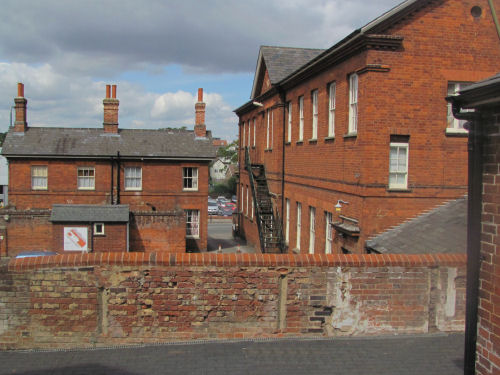|
The Great Lancasterian Schoolroom
This room was built in 1837 to teach on the
monitor system. The floor was originally sloping to give the
teacher a better view of the 150 boys. The idea was that one
teacher could teach a large number, with older boys (monitors)
surviving and instructing the younger ones.
The room is the only example of such a classroom
to survive anywhere in the world, and is currently in a
partially restored state. |
 |
|
 |
The Gallery Classroom
This was built in 1854 and desk are arranged on a
slope to provide the boys with a good view of the teacher.
This room was well organised for handling a party
of school children, with a "teacher" demonstrating various
aspects for how teaching was carried out a hundred years ago.
|
|
The Edwardian Classroom
Two extra classrooms were added in 1905 and this
one has been furnished in the style of the period, using desks
with fixed seats.
|
 |
|
 |
The 1940's Classroom
This classroom was built in 1905 but has been
equipped to represent how it would have been furnished in about
1940, when the Second World War was on, and the school had expanded to
accommodate evacuee children from London.
There were a number of features here which brought
back memories of my own childhood. |
|
The Girls School
In 1845 the original building that had housed the
girls and infants burnt down and the replacement was deemed
unsatisfactory and this more substantial building was erected in
1857.
The upper floors are not open to the public, and
the ground floor was used as an activity room aimed at visiting
children, a museum, a small refreshment room and a shop. |
 |
|
 |
The Headmaster's House
A view from the boys' playground over the wall
with the girls' playground at a lower level, and the
headmaster's house beyond. |
|
Inside the Headmaster's House
Part of the house was furnished as it would have
been about one hundred years ago. I didn't have time to view the
upstairs but the living room, kitchen and scullery had plenty to
interest visiting schoolchildren (and adults).
The tiny backyard was also of the period -
including the little necessary outside room (no longer
functioning) |
 |
|
Update July 2014 |
And
the First World War Exhibition |
 |
Lancasterian Classroom
In
July 2014 I visited the school again, this time with the
Genealogy Group of the Tring U3A, and I have added some more
pictures which complemented those taken earlier.
We were all made to sit down at on the forms so
that we could be told about the early teaching methods used in
the school. This approach is used with visiting school parties
to help them understand how educational methods have changed
over the years. |
|
Gallery Classroom
Our "Headmaster" took the class in the way his
predecessor might have taken a class in Victorian Times with an
emphasis on rote learning. We were taught to do arithmetic using
pounds, shillings and pence using a slate and slate pencil to do
the sums. Because we Oldies had grown up with the real thing we
did much better than modern children do. We wrote with pen
and ink in a copy book - and when appropriate a dunce's cap was
used - and the cane applied with vigour! The picture shows us
all having our hands inspected to make sure we had washed
properly before coming to school. |
 |
 |
|
The party then went on to the
Edwardian Classroom where the war memorial to former
pupils had recently been unveiled.
 |
The Edwardian Classroom now has a display panel relating to
the First World War
and a memorial to the men who had been educated in the
school and gave their lives in the war.
|
|
The Girls School - Main Room
This was used for the First World War Exhibition
with four large show cases with interesting displays, relating
to the war, the school in war time, and the people involved. In
addition there was a small case including examples of trench
art, and a number of informative display panels.
There were also a number of
tables in the room that could be used by patrons who purchased a
drink, etc., at the little cafe. |
 |
 |
|
In the shop the latest addition was
the book
Remembered with Pride
by Jean Handley
This is a carefully researched
account of pupils form the school who lost their
lives in the Great War. It includes biographical
details, and accounts of the the battles where they
lost their lives, or in some cases died in the 1918
flu epidemic while in the armed forces. Because of a
personal interest I looked to see if any had died in
the battle of Cambrai in December 1917. I
found that Charles Marcus Barker was in one of the
tanks when he was killed while Edward Christopher
Halsey died in fighting the following January.
Many people are currently researching
the lives, and military service, of those who died
from their school, works, villages and towns, and
this book can be taken as a really good example of
what can be achieved. |
Discovery Room
The room beyond the shop is a room where
children can find out much about school and everyday life in
the past, and is an important part of the museum's
educational role.
Like many such enterprises the museum
is very dependent on volunteers, like the ones who showed us
round, and fund raising is always a problem. If you are
researching your ancestors they will, at least in part of
the 19th century, and all of the 20th century, have gone to
school. It really makes you think about how they were taught
if you sit through a short lesson in the Lancasterian or
Gallery classrooms. If you are going anywhere near Hitchin
the Museum is well worth a visit (but check the opening
times) - and if your ancestors grew up in Hitchin the
Museum's archives may well have something about them.
|
|
|
|
|
